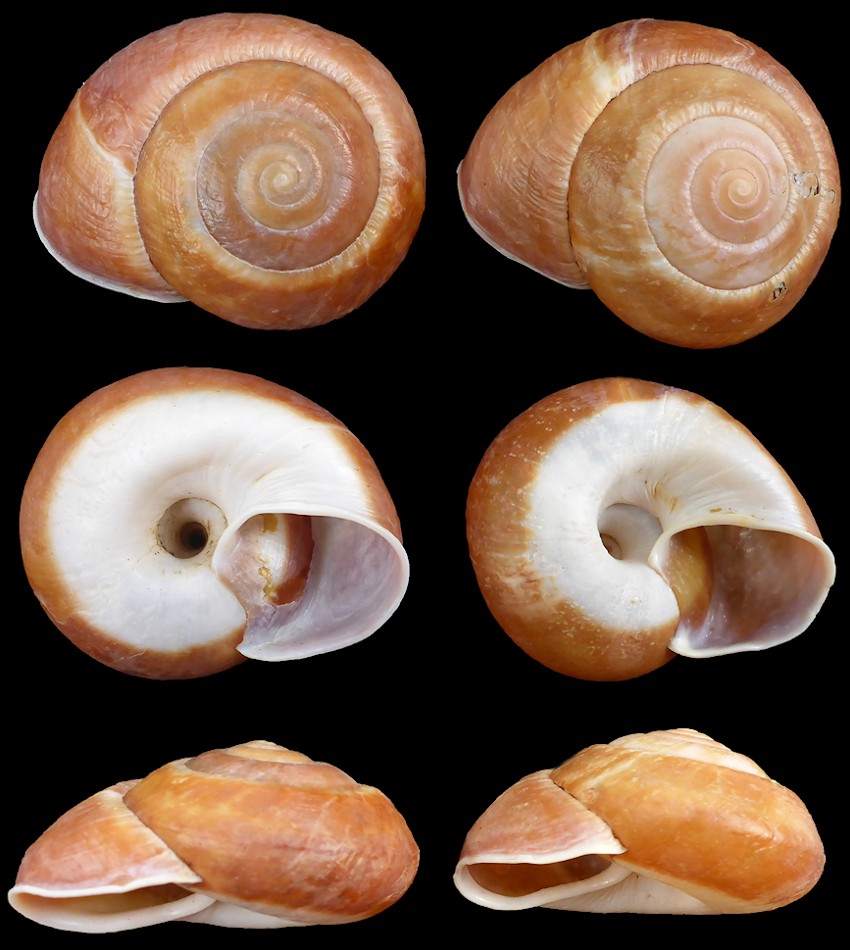|
Aegistohadra contractiva (Mabille, 1889) comb. nov. |
|
|
|
North of Hekou, Yunnan
Province, Peoples Republic of China. The larger of the pair measures
40.9 mm Dmax. Lee collection.
Helix (Camaena) contractiva Mabille, 1889: 6. was described from Tonkin. Bavay and Dautzenberg (1909b: 172 <http://biodiversitylibrary.org/page/27393333>) considered this species variable in size, shape, and chirality (e.g., “Monstr. dextrorsum nov. ...... [possibly] "enroulement indifférent"). They figured “le type de cette espèce” [fide Joubin] for the first time (Idem: pl. 5, figs. 1-3: <http://biodiversitylibrary.org/page/27393442>). Three syntypes, MNHN 2000-2022, are posted at The Paris Museum's database <https://science.mnhn.fr/taxon/species/helix/contractiva>. The first of these bears a very close resemblance to the aforementioned "type." The other two shells look a lot like the specimens above, which, in accordance with B. & D. (ibid), are here considered mere forms of the "type" - but with some reluctance; see Aegistohadra rara in this webfeature. Helix seraphinica Heude, 1890a: 225; 1890b: 141 <http://biodiversitylibrary.org/page/34061545>; pl. 38, figs. 11 [n=2] <http://biodiversitylibrary.org/page/34061605>) N. of Hekou, Yunnan Province, China. Named for its collector, Père Séraphin Couvreur (1835-1919), it is also quite similar to syntypes 2 & 3 and the shells figured above, their lips being more deflected and profile lower than syntype 1 (? "le type"). Is this a junior synonym of the Mabille taxon, as considered possible by B. & D. (Idem: 172-173)? Is the "real" H. contractiva syntype 1, and syntypes 2 & 3 H. seraphinica? More and better material (shells, anatomy, & tissue for molecular genetics) may clarify these relationships. Of considerable interest is the fact that Wu (2004: 118) expressed belief that this nominal taxon belonged in his new genus Aegistohadra, but he had no anatomic material for confirmation. He found two paratypes at The institute of Zoology, Chinese Academy of Sciences, Beijing (Wu, Idem: 118, figs. A-F: IZCAS-type-3071-1, 2 <https://www.biodiversitylibrary.org/page/28112688>), which are quite likely conspecific with the iconotype. The Holotype of this species, (and all of Heude's taxa) probably remained in his museum in Shanghai (Fischer, 1904; Johnson, 1973; Li-chuan, 2013), predecessor to the Shanghai Natural History Museum. Johnson (idem) cited two other paratypes (MCZ 167156 and USNM 472130 [both confirmed on-line but no type status given]). No indication of dextral material was made by the author, Père Pierre Marie Heude (1836-1902 <https://en.wikipedia.org/wiki/Pierre_Marie_Heude>) or Wu (2004). See discussion of Aegistohadra effusa. Bavay, A. and P. Dautzenberg, 1909a. Molluscorum terrestrium Tonkinorum diagnoses. Journal de Conchyliologie 56: 229-251 <http://biodiversitylibrary.org/page/16298225> Bavay, A. and P. Dautzenberg, 1909b. Description de coquilles nouvelles de l'Indo-Chine (5e suite). Journal de Conchyliologie 57: 163-206 <http://biodiversitylibrary.org/page/27393324>, plates 4-8 <http://biodiversitylibrary.org/page/27393440>. Fischer, P., 1904. Nécrology Le R.P. Heude. Journal de Conchyliologie 52(4): 372-375. <https://www.biodiversitylibrary.org/page/16290594> Heude, P.M. (1882-1890): Notes sur les mollusques terrestres de la vallée du Fleuve Bleu. Mémoires d'Histoire naturelle de l'Empire chinois 1(2): 2 + 1-87 <https://www.biodiversitylibrary.org/page/34061405>, pls. 12-21 <https://www.biodiversitylibrary.org/page/34061438> [1882]; 1(3): 89-132 <https://www.biodiversitylibrary.org/page/34061459>, pls. 22[23]-32 <https://www.biodiversitylibrary.org/page/34061506> [1885]; 1(4): 125-188 <https://www.biodiversitylibrary.org/page/34061527>, pls. 33-43 <https://www.biodiversitylibrary.org/page/34061594> [1890b]. Heude, P.M., 1890a. Diagnoses molluscorum novorum in Sinis collectorum [part 2 of 2]. Journal de Conchyliologie 37(3): 225-229. 27 January. <https://www.biodiversitylibrary.org/page/16015587> Johnson, R.I., 1973. Heude’s molluscan types: or, Asian land and fresh water mollusks, mostly from the People’s Republic of China, described by P. M. Heude. Special Occasional Publication 1 Museum of Comparative Zoology, Harvard University: 1-111. Before December 3 <https://www.biodiversitylibrary.org/item/25355> Li-chuan, T., 2013. English abstract; pp. 384-385 in Zikawei Museum to Heude Museum: The Natural History Research of French Jesuits in Modern China [multiple authors]. <https://tinyurl.com/27bpku9n> Mabille J., 1889. Contributions a la faune macalogique [sic] du Tonkin. Masson, Meulan (France). 20 pp. [no figure]. <https://www.molluscabase.org/aphia.php?p=sourcedetails&id=336403> Wu, M., 2004. Preliminary phylogenetic study of Bradybaenidae (Gastropoda: Stylommatophora: Helicoidea). Malacologia 46: 79-125. <https://www.biodiversitylibrary.org/page/28112649>See also: Lee, H.G., 2022. Aenigmatic Aegistohadra Part 2 (conclusion) -or- an account of a pretty astounding clade of sinistral and enantiomorphic land snail taxa. Shell-O-Gram 63(4): 3-10. July. (Link) |
